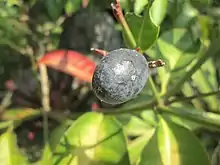Kopsia arborea
Kopsia arborea is a tree in the family Apocynaceae.
| Kopsia arborea | |
|---|---|
 | |
| Scientific classification | |
| Kingdom: | Plantae |
| Clade: | Tracheophytes |
| Clade: | Angiosperms |
| Clade: | Eudicots |
| Clade: | Asterids |
| Order: | Gentianales |
| Family: | Apocynaceae |
| Genus: | Kopsia |
| Species: | K. arborea |
| Binomial name | |
| Kopsia arborea | |
| Synonyms[2] | |
Description
Kopsia arborea grows up to 14 metres (50 ft) tall, with a trunk diameter of up to 10 centimetres (4 in). The bark is grey. Its flowers feature a white corolla. The fruits are blue-black, ellipsoid or roundish, up to 4.2 cm (2 in) long.[3] In China, local traditional medicinal uses include as an enema and as a treatment for tonsilitis.[4]
Distribution and habitat
Kopsia arborea is native to China, Thailand, Vietnam, Malesia and Australia.[1][5] It is found in a variety of habitats from sea level to 1,500 metres (5,000 ft) altitude.[3]

Fruit
References
- Yu, S.; Qin, H.; Botanic Gardens Conservation International (BGCI) & IUCN SSC Global Tree Specialist Group (2019). "Kopsia arborea". IUCN Red List of Threatened Species. 2019: e.T147643327A147643329. Retrieved 24 August 2020.
- "Kopsia arborea". Plants of the World Online. Royal Botanic Gardens, Kew. Retrieved 24 August 2020.
- Middleton, David J. (September 2004). "Kopsia arborea Blume". In Soepadmo, E.; Saw, L. G.; Chung, R. C. K. (eds.). Tree Flora of Sabah and Sarawak. (free online from the publisher, lesser resolution scan PDF versions). 5. Forest Research Institute Malaysia. p. 37. ISBN 983-2181-59-3. Archived from the original (PDF) on 27 September 2013. Retrieved 7 August 2013.
- "Kopsia arborea". eFloras. Retrieved 7 August 2013.
- Hyland, B. P. M.; Whiffin, T.; Zich, F. A.; et al. (Dec 2010). "Factsheet – Kopsia arborea". Australian Tropical Rainforest Plants (6.1, online version RFK 6.1 ed.). Cairns, Australia: Commonwealth Scientific and Industrial Research Organisation (CSIRO), through its Division of Plant Industry; the Centre for Australian National Biodiversity Research; the Australian Tropical Herbarium, James Cook University. Retrieved 4 Nov 2013.
| Wikimedia Commons has media related to Kopsia arborea. |
This article is issued from Wikipedia. The text is licensed under Creative Commons - Attribution - Sharealike. Additional terms may apply for the media files.
